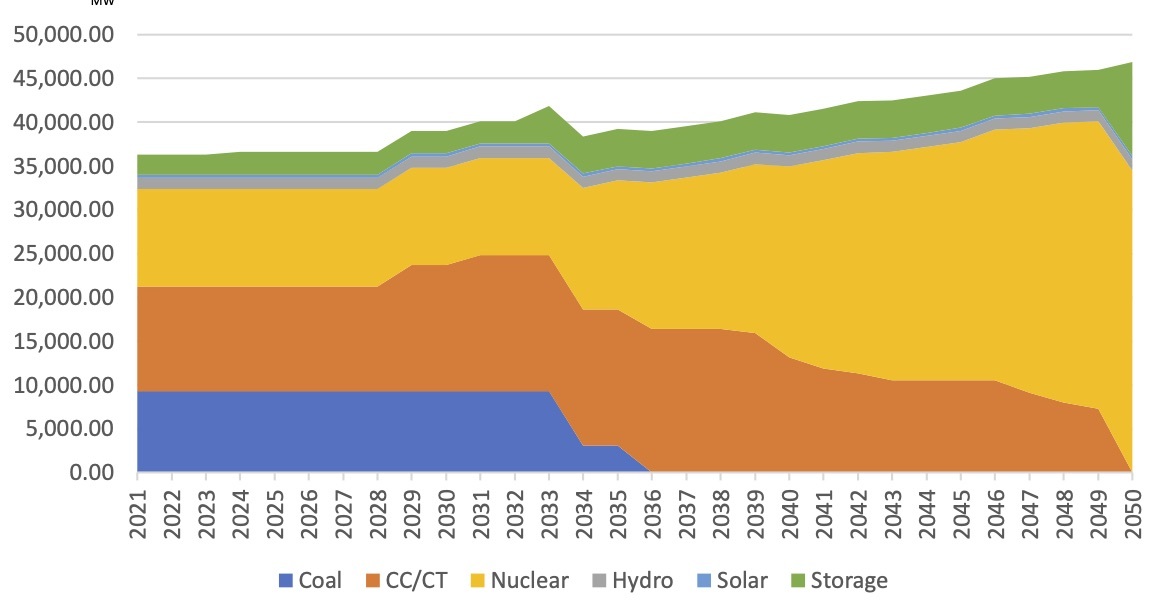Duke Energy Corporation has filed its update resource plan with the North Carolina Utilities Commission (NCUC). This action follows the NCUC’s initial Carbon Plan and the U.S. Supreme Court’s action allowing construction to resume on the Mountain Valley Pipeline (MVP). Duke included three core portfolios in this plan but made clear that Portfolio 3 (P3) is the preferred option.
That portfolio by 2038 contains several noteworthy features: the most new nuclear generation (2.4 gigawatts, or GWs), the most new natural gas–fired generation (combined 7.1 GWs of combined-cycle and combustion-turbine generation), and zero offshore wind. It would still add a significant amount of new solar capacity (14.6 GWs) and battery arrays (6.0 GWs) as well as 2.3 GWs of new onshore wind capacity, however. Adding new nuclear, adding new natural gas, and avoiding offshore wind are overall welcome outcomes for North Carolina electricity customers, all things considered.
Resource Additions for Duke Core Portfolio Proposals by 2038, by Proposal and Resource

Source: Duke Energy, “2023 Carbon Plan and Integrated Resource Plan”
It’s worth understanding the policy landscape affecting Duke’s plan. It includes:
- recent state law requiring changing the resource mix to achieve a 70 percent reduction in carbon dioxide (CO2) emissions from electricity generation by the 2030s to culminate in zero CO2 emissions (carbon neutral) by 2050
- the NCUC’s directives to Duke to retire and replace all coal-fired power generation in North Carolina by 2035 — representing over 9,000 megawatts (MWs) of low-cost, dispatchable, baseload generation, making up one-fourth of installed capacity in the state
- Duke’s expectation for a great increase in electricity demand over time (by 35,000 GW-hours by year 2038), especially to support “large industrial projects” (the plan specifically cites, among others, Gov. Roy Cooper’s major corporate-welfare recipients VinFast, Wolfspeed, and Toyota), “cloud-based and artificial intelligence computing services,” and “the projected adoption of EVs by both residential and commercial customers” (recall that Cooper “ordered” that by 2030 half of all vehicle sales in the state must be EVs and then “ordered” that North Carolina abide by California Gov. Gavin Newsom’s wish to transition to zero-emissions trucks and buses)
- the law’s requirements that the resource mix charting the “path” to carbon neutral electricity generation be the “least-cost path” and comply with “current law and practice” regarding “least cost planning of generation” that will “maintain or improve upon the adequacy and reliability of the existing grid”
The takeaway is this: Duke has to be very careful how it plans to replace coal-fired generation. The replacement sources must uphold reliable power provision (power expected at the flip of a switch) as well as keep costs low, as should sources of new generation.
Duke cannot therefore sling out a plan like Gov. Cooper’s “Clean Energy Plan,” which was put together with the input of 164 environmental and other “stakeholder” groups who openly admitted they had little interest in “Affordability” and “Reliability” as “Values to prioritize going forward.” Their plan’s initial draft excluded nuclear altogether. After critics pointed out that glaring omission, however, it was revised to end with a “straightforward, categorical rejection of nuclear power.”
Duke’s preferred portfolio nods to practical reality. As Locke’s Center for Food, Power, and Life has demonstrated repeatedly, low-emissions natural gas and zero-emissions nuclear generation (both steady, reliable baseload sources with very small land footprints) are the responsible way forward. The law’s requirements cannot be achieved via intermittent, expensive, sprawling, and weather-dependent “renewable” sources such as solar and wind, especially not offshore wind.
Our analysis presented before the NCUC showed that the lower-cost path to the compliance with the law’s CO2 emissions reduction goals could be achieved by adding more zero-emissions nuclear power, pumped storage, battery storage, and natural gas facilities:
Model Least-Cost Decarbonization Portfolio: Nuclear, Pumped Storage, Battery Storage, and Natural Gas

Isaac Orr of the Center of the American Experiment, who along with colleague Mitch Rolling produced the modeling for our analysis to the NCUC, called Duke’s P3 “smart,” noting:
Gradually replacing coal plants with new nuclear facilities will save hundreds of billions of dollars compared to attempting to replace them with wind, solar, and battery storage and provide a superior reliability value to North Carolinians.
Duke shows the same in its new plans. All of P1’s new offshore wind, solar, batteries, and hydrogen resources are simply “unattainable” and decidedly more expensive, so cost comparisons must be between P2 and P3. Even with P3’s “aggressive level of resource additions,” Duke finds it achieves “lower execution risks and lower costs relative to P2 due to requiring 2,600 MW less batteries by 2033 and allowing time for lower cost clean resources to meet energy needs that are supplied by offshore Wind in P2 Base” (emphasis added).
Waiting for more nuclear, adding more natural gas, keeping expensive offshore wind at bay, and building less battery capacity results in Duke’s finding that P3 would save “nearly $5 billion” relative to P2 by 2050.


